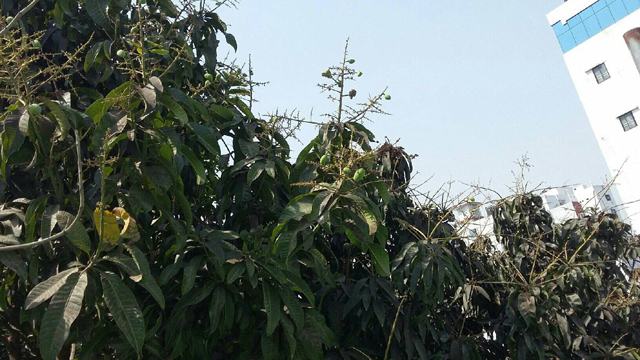News Flash
News Flash

By Md Aynal Haque
RAJSHAHI, April 6, 2024 (BSS) - As per natural tradition and timeframe, the mango formation is going on smoothly amid favorable climatic conditions, giving a signal of coming of the most popular juicy fruit in Rajshahi and Chapainawabganj districts within the next couple of months.
The fruit setting stage is progressing well and many of the mango trees have started wearing eye-catching looks in the orchards, gardens and homestead areas.
According to the sources close to the Department of Agriculture Extension (DAE), there are a lot of buds in the new mango orchards in Naogaon this year.
However, relatively fewer buds have appeared on the big trees of Rajshahi and Chapainawabganj. Mangoes are being produced on 93 thousand hectares of land in Naogaon, Rajshahi and Chapainawabganj.
DAE Additional Director Mahmudul Faruque said that more than 50 percent of the buds have turned into pods in the region. In Rajshahi, 65 percent of the mango buds are currently pea-sized, while 35 percent are marble-sized.
In his remarks, Dr Shafiqul Islam, principal scientific officer of Fruit Research Station, said last year's bumper crop resulted in less food storage in the trees, leading to a lower bud count this year. But reduced production this year is anticipated to yield larger mangoes of higher quality.
He clarified that the buds have come late on the trees due to the prolonged winter. Usually, buds appear on most trees in early February, but this time buds started appearing on trees in late February.
Uneven distribution of buds is another unusual observation.Some orchards have trees with full bud coverage while neighbouring trees have none, with only new leaves emerging.
This pattern is also seen on individual trees, where one branch may be covered in buds while the other remains bare.
Shafiqul Islam Sana, 47, a potential mango grower from Bagha, who sold mangoes worth about Tk1 crore last year, is cultivating mangoes on 300 bighas of land this year as well. However, he is disappointed as fewer buds have appeared on the trees.
He said that compared to last year, not even 50 percent of the buds have appeared on the trees this year. Some of the mango buds and pods have fallen off due to hailstorms.
Sana, however, said there is still hope for a good quality harvest.
Shafiullah Sultan, Upazila Agriculture Officer at Bagha, said that if at least 20 percent of the pea-sized pods survive, the mangoes will have a chance to grow bigger and be of better quality.
Similar conditions are observed in Charghat upazila, where farmers report only seeing leaves on their trees rather than mango pods.
Biplob, a mango grower of Chara Bottola area of the upazila, said that he sold Tk22 lakh worth of mangoes last year. This year he will not even get Tk2 lakh worth of mangoes.
He said he sprayed pesticides on the mango trees to protect them from pest attack and have good sprouting.
Al Mamun Hasan, Upazila Agriculture Officer, however, said that 50 percent of the buds have turned into pods in the upazila.
He said they are suggesting the farmers for proper nursing of their orchards and gardens at this stage and controlling pests' attacks, if any, with temperature rise, by mango hoppers now, or sometime later by weevils or other insects for better mango production.
Abdur Razzak, is taking a proactive approach. He is busy taking care of them and has done the second round of pesticide spraying on the trees. He said that pods have appeared on 500 out of 900 trees in his orchard.
There was a bumper production of mangoes last year. However, this year's production is apprehended to be reduced.
Yadul Islam, who has rented 376 mango trees inside the field of Bangladesh Council of Scientific and Industrial Research for three years, said that although the buds are less in other places, the buds in his orchard were good this year, with about 75 percent of the trees having mango buds.
He opined that mangoes survive by facing natural calamities. If the existing buds on the trees survive and the farmers take proper care, the target set for mango production will be met.